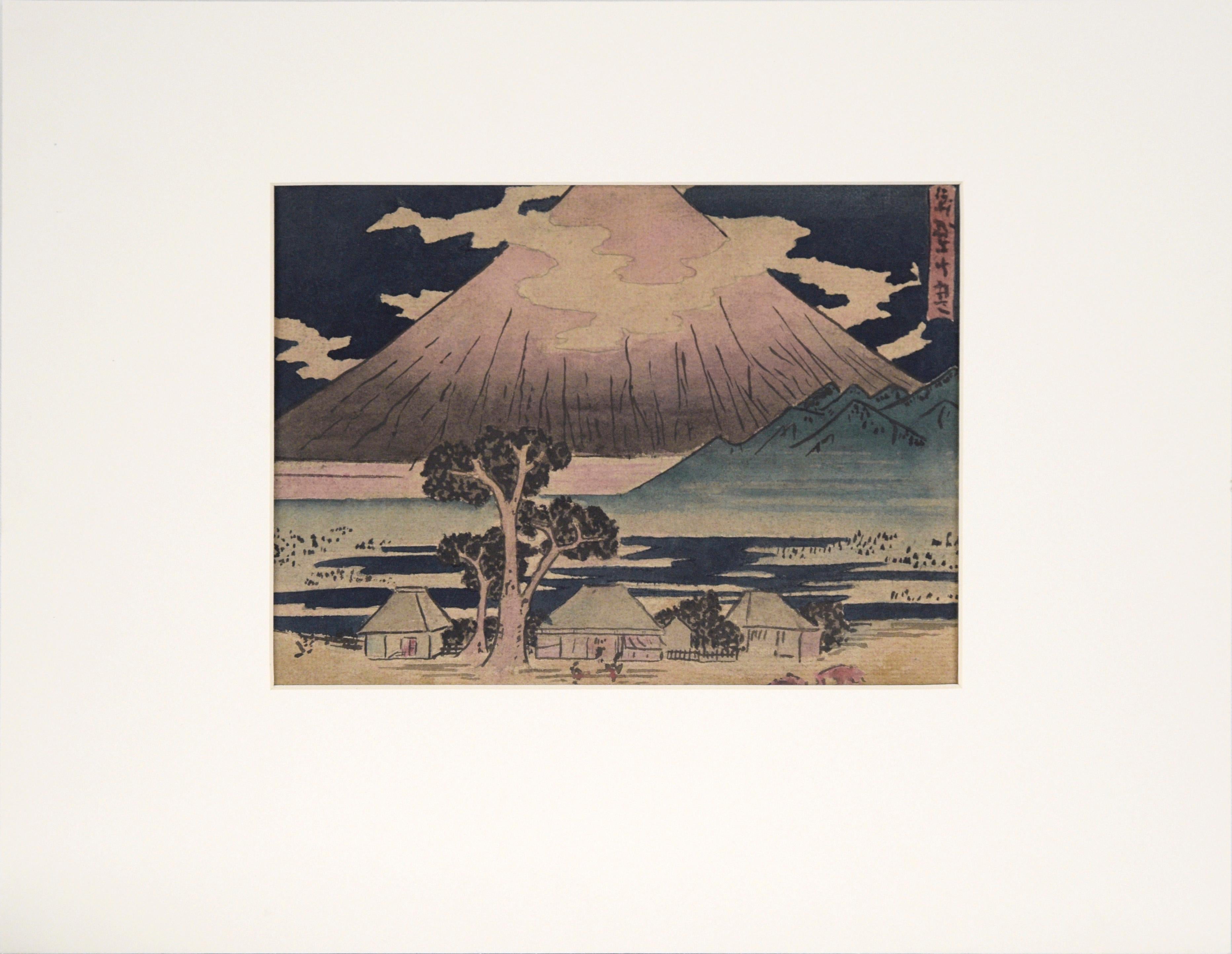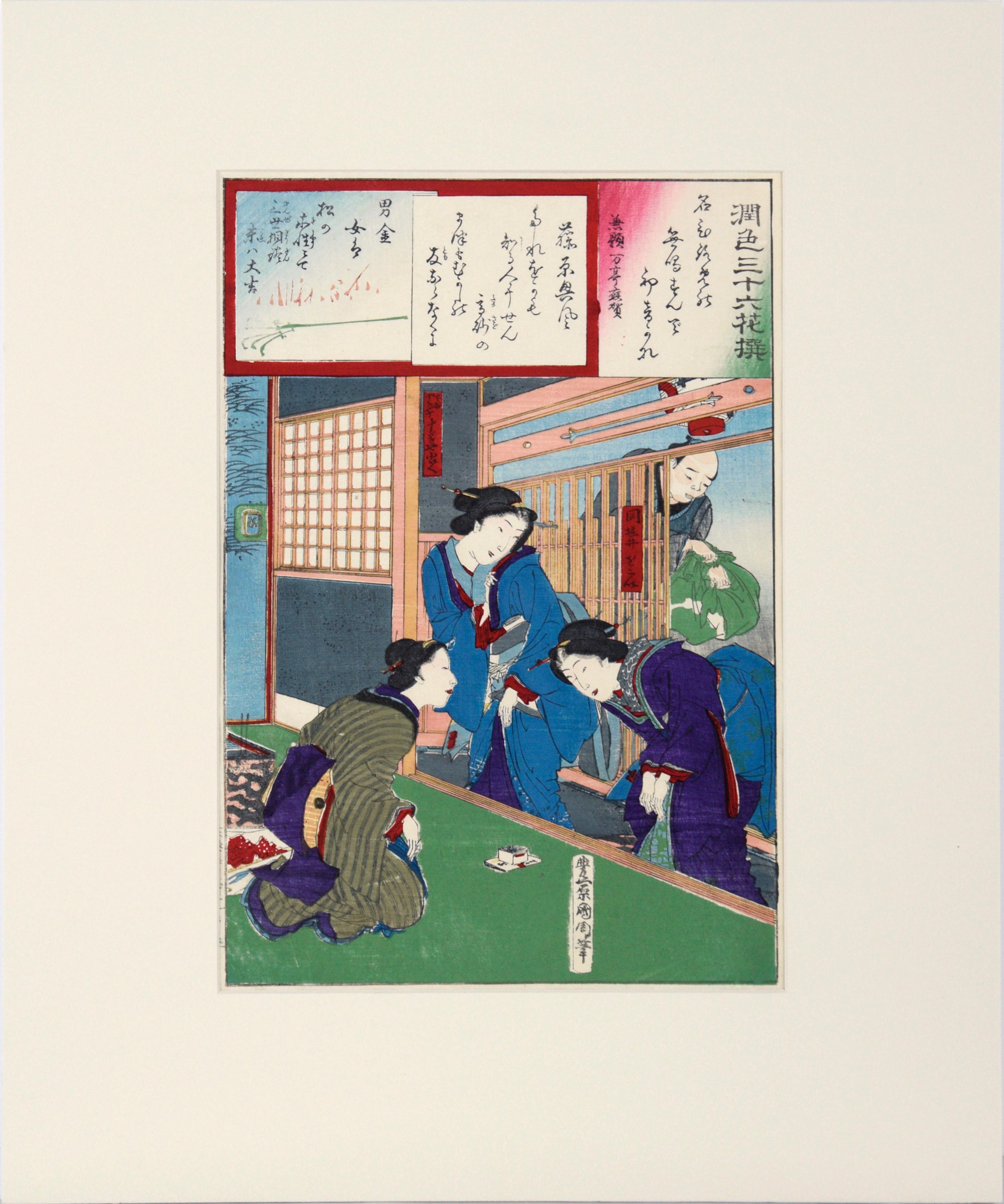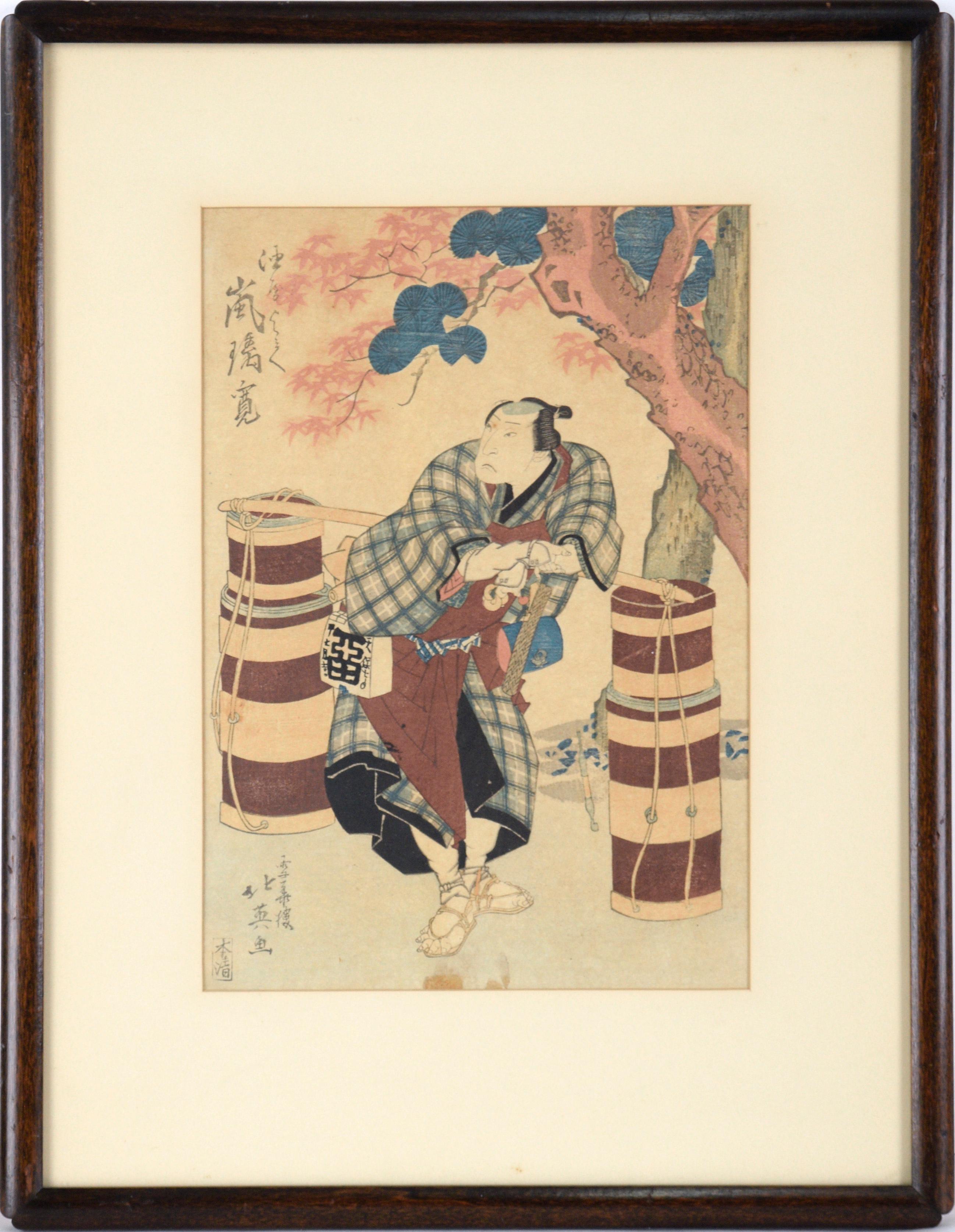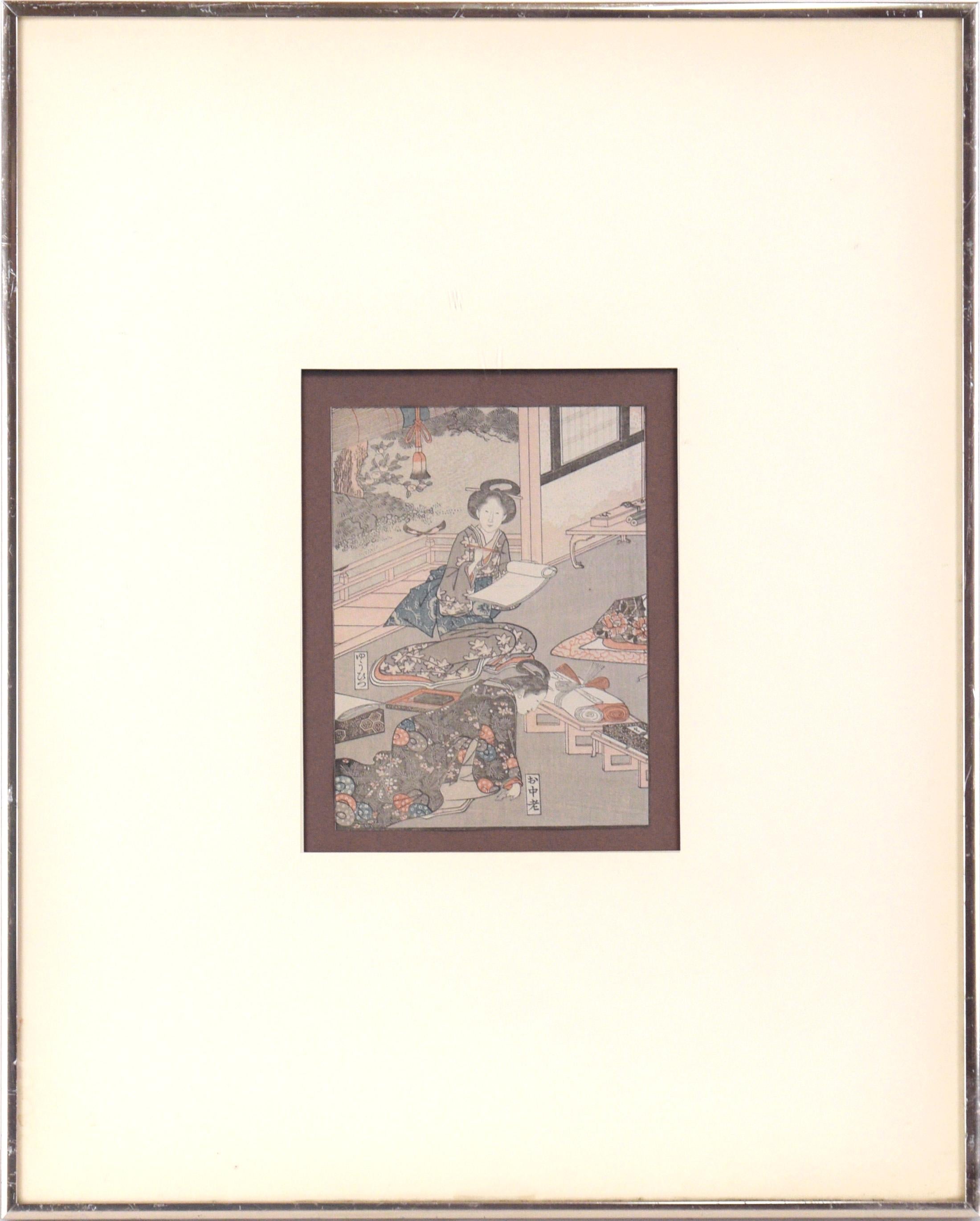Items Similar to "Juro Sukenari, Station #9: Oiso", Mid 19th Century Japanese Ukiyo-e Woodblock
Want more images or videos?
Request additional images or videos from the seller
1 of 13
Utagawa Kunisada (Toyokuni III)"Juro Sukenari, Station #9: Oiso", Mid 19th Century Japanese Ukiyo-e Woodblock1852
1852
About the Item
Beautiful mid 19th century Japanese woodblock print of a samurai by Utagawa Toyokuni III (Kunisada) (Japanese, 1786-1864/5). This piece is from a series of "The 53 Stations of the Tokaido" and was originally a diptych. It depicts the actor Ichimura Uzaemon XII in the role of Juro Sukenari, in the play Soga Mono. Artist's chop is on the right edge of the piece. Presented in a cream mat, with a black and red frame and plexiglas. Image size ~14.5"H x 10.5"W
During his lifetime Kunisada Utagawa was considered to be the best print designer by his contemporaries. He was more popular than Hiroshige, Hokusai or Kuniyoshi. And Kunisada was extremely productive. His total output is estimated at more than 20,000 designs, many made by his students.
Kunisada was born near Edo (today Tokyo) as the son of an affluent merchant with a ferry boat license. At the age of fifteen he joined the famous art school of Utagawa Toyokuni and took the name Kunisada.
In 1807 the young artist produced his first illustrated book. And in 1808 his first actor prints were published. His fame grew fast. While other artists like Kuniyoshi Utagawa or Hiroshige had to fight for recognition for years, he was successful from the beginning.
He should become the most commercially successful of all woodblock printmakers ever. His early success may not have had a good influence on his personality. He had a reputation for his conceited personality.
Kunisada designed a wide spectrum of traditional ukiyo-e subjects like kabuki themes, beautiful women, historical events and quite a few shunga prints. He made few landscapes.
- Creator:Utagawa Kunisada (Toyokuni III) (1786-1864, Japanese)
- Creation Year:1852
- Dimensions:Height: 21.63 in (54.95 cm)Width: 17 in (43.18 cm)Depth: 1 in (2.54 cm)
- Medium:
- Movement & Style:
- Period:
- Condition:Tonal ageing to paper, as expected for a piece of this age. Otherwise in very good condition. Damage to frame (repaired). Minor scratches on plexiglas.
- Gallery Location:Soquel, CA
- Reference Number:
About the Seller
4.9
Platinum Seller
These expertly vetted sellers are 1stDibs' most experienced sellers and are rated highest by our customers.
Established in 1986
1stDibs seller since 2014
2,520 sales on 1stDibs
Typical response time: <1 hour
- ShippingRetrieving quote...Ships From: Soquel, CA
- Return PolicyA return for this item may be initiated within 14 days of delivery.
More From This SellerView All
- Study of Utagawa Hiroshige's "View of Hara-Juku" 53 Stations of the Tokaido RoadBy Utagawa HiroshigeLocated in Soquel, CAStudy of Utagawa Hiroshige's "View of Hara-Juku" 53 Stations of the Tokaido Road Hand painted study of Utagawa Hiroshige's "View of Hara-Juku", (by unknown artist), from "53 Station...Category
1920s Edo Landscape Prints
MaterialsWoodcut, Paper, Ink
- "Enshoku Sanju-roku Kasen" (Thirty-six Enchanting Flowers) Woodblock on paperBy Toyohara KunichikaLocated in Soquel, CA"Enshoku Sanju-roku Kasen" (Thirty-six Enchanting Flowers) Woodblock on paper Elegant woodblock print by Toyohara Kunuchika (Japanese, 1835-1900). Three women are in talking with each other inside, while a man waits outside holding a bag of some kind. The colors in this piece are rich and saturated, primarily blues, greens, and purple. Mat size: 16"H x 20"W Paper size: 14.75"H x 9.88"W Born in 1835, Toyohara Kunichika grew up in the Kyobashi district of Edo in the midst of merchants and artisans. In 1848, at age 13, he was accepted as an apprentice into the studio of Utagawa Kunisada I...Category
1880s Edo Figurative Prints
MaterialsInk, Rice Paper, Woodcut
- Elegant Amusements of Eastern Genji - Japanese Triptych Woodblock Print on PaperBy Utagawa Kunisada (Toyokuni III)Located in Soquel, CAElegant Amusements of Eastern Genji - Japanese Triptych Woodblock Print on Paper Dynamic woodblock print with several elegantly dressed figures by Utag...Category
1850s Edo Figurative Prints
MaterialsPaper, Ink, Woodcut
- Dressing Room 53 Stations of Tokaido - Woodblock Utagawa Hiroshige and KunisadaBy Utagawa Kunisada (Toyokuni III)Located in Soquel, CADressing Room 53 Stations of Tokaido - Woodblock Utagawa Hiroshige and Kunisada Elegant woodblock print by Utagawa Hiroshige I (Japanese, 1797–1858) and Utagawa Kunisada I...Category
1850s Edo Figurative Prints
MaterialsPaper, Ink, Woodcut
- Scribe and Personal Assistant to the Shogun - Japanese Woodblock Print on PaperLocated in Soquel, CAScribe and Personal Assistant to the Shogun - Japanese Woodblock Print on Paper Detailed woodblock print by an unknown artist, In the style of Suzuki Harunobu. There are two women i...Category
19th Century Edo Figurative Prints
MaterialsPaper, Ink, Woodcut
- Actor Arashi Rikan II as Aburaya Yohei - Figurative Woodblock Print on PaperLocated in Soquel, CAActor Arashi Rikan II as Aburaya Yohei - Figurative Woodblock Print on Paper Woodblock print of kabuki actor by Shunbaisai Hokuei (Japanes...Category
1830s Edo Figurative Prints
MaterialsPaper, Ink, Woodcut
You May Also Like
- Seishi Ai-oi Genji – Set of 12 Shunga works together w/astrological commentaryBy Utagawa Kunisada (Toyokuni III)Located in Middletown, NYSet of 12 woodblock prints in colors on handmade, laid mulberry paper, 6 3/4 x 10 1/4 inches (170 x 258 mm), printed in Ka-ei 4 (1851). Each print with minor handling wear, otherwise in excellent condition with bright and fresh color, and with details printed in silver ink. The images themselves contain several illusive characters indicating the publisher which are obfuscated by figures, as intended. Presented loose, as issued. A fine set. The astrological commentary print has a large and meandering blind stamp with a bird and palm frond motif. This print lists various phrases concerning the Twelve Zodiac Animals as historically counted in Japan, and appears to include erotic commentary on the traits of people born under each of the twelve signs. These Shunga images were issued in books that paralleled (in an erotic fashion...Category
Mid-19th Century Edo Nude Prints
MaterialsHandmade Paper, Ink, Woodcut
- Drying PaperLocated in Middletown, NYWoodcut on cream laid paper, 7 1/4 x 2 1/2 inches (182 x 63 mm), narrow margins. Laid down to non-archival board with scattered soiling and some adhesive staining. Okumura Masanobu (Japanese 1686 – 13 March 1764) was a Japanese print designer, book publisher, and painter. He also illustrated novelettes and in his early years wrote some fiction. At first his work adhered to the Torii school, but later drifted beyond that. He is a figure in the formative era of ukiyo-e doing early works on actors and bijin-ga ("pictures of beautiful women"). While Masanobu's early life is largely undocumented, he is believed to have been born about 1686, possibly in Edo (modern Tokyo). Edo was a small fishing village when Tokugawa Ieyasu chose it as his administrative capital of the Tokugawa shogunate, and by the early 17th century the city had prospered and its population had grown to half a million. Masanobu appears to have been self-taught painter (though he did study poetry under Tachiba Fukaku); he is not known to have belonged to any artistic school. His early work shows the influence of the Torii school of ukiyo-e painting...Category
Early 18th Century Edo Figurative Prints
MaterialsHandmade Paper, Woodcut
- Toshogu ShrineLocated in Middletown, NYIn image of the Tokugawa family paying homage to Tosho-gu Shrine in Nikko. Tokyo: Matsuki Heikichi, 1896 Woodcut in ink with embossing and hand-coloring in watercolor on handmade m...Category
Late 19th Century Edo Figurative Prints
MaterialsHandmade Paper, Watercolor, Woodcut
- Japanese Beauty Admiring Kirifuri WaterfallBy Yoshu ChikanobuLocated in Burbank, CAA beauty turns to admire the Kirifuri Waterfall in Nikko Province. She holds the handle of an umbrella and wears fashionable clothing that is beautifully printed. This series pairs f...Category
1890s Edo Landscape Prints
MaterialsWoodcut, Handmade Paper, Mulberry Paper
- Beauties on the Beach with view of Mount FujiBy Yoshu ChikanobuLocated in Burbank, CAShichirigahama, Sagami Province. A beauty in the foreground waves to her young companions, who run towards her on the beach. The beauty at left wears a western-style golden ring. We ...Category
1890s Edo Landscape Prints
MaterialsHandmade Paper, Mulberry Paper, Woodcut
- Japanese Beauties Enjoy a Full MoonBy Utagawa Kunisada (Toyokuni III)Located in Burbank, CA"Sun, Moon and Stars". Three beauties enjoy a full moon on the veranda of a teahouse or restuarant. The woman on the left kneels and adjusts her lavishly printed kimono. The beauty in the center has her hair down, and behind her is a screen against which shadows are beautifully silhouetted, which adds an air of mystery. The seated woman on the right is perhaps a geisha, as we see a shamisen lying next to her. Before her is a tray with an assortment of foods. One may surmise that the beauties are being compared to the sun, the moon, and the stars. On the left we glimpse a full moon shining over the peaceful bay, and boats at harbor. Original first edition Japanese color woodblock print triptych...Category
1840s Edo Figurative Prints
MaterialsMulberry Paper, Woodcut
Recently Viewed
View AllMore Ways To Browse
Japanese Mid Century Design
Japanese Midcentury Design
Mid Century Japanese Paper
Antique Station
Women Size 9
1860 Japan
Antique Chop
19th Japanese Samurai
Antique Japanese Book Prints
Kabuki Woodblock Prints
Antique Japanese Woodblock Prints Hiroshige
Toyokuni Iii
Toyokuni Iii Utagawa
Japanese Woodblock Prints Book
Japanese Print Toyokuni
Samurai Woodblock
Japanese Woodblock Prints Samurai
Japanese Woodblock Samurai





